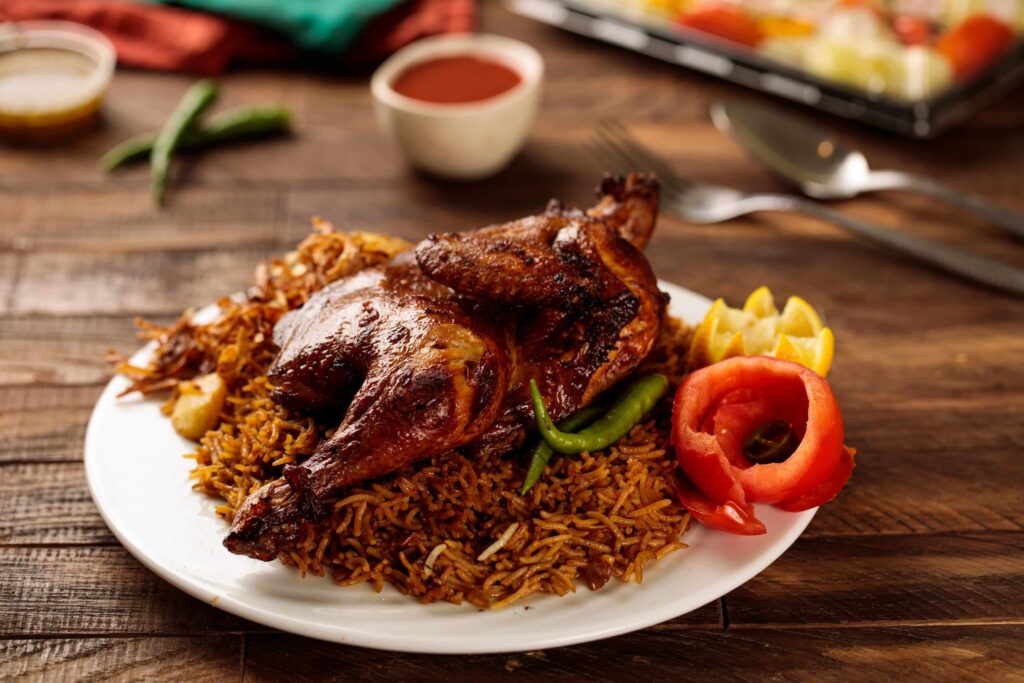
Machboos, a well-known dish in the United Arab Emirates (UAE), is often enjoyed by locals and tourists alike. This flavorful meal, deeply rooted in Emirati culture, offers a unique culinary experience that reflects the region’s rich history and diverse influences.
Our team at Remitly created this guide as part of our series that celebrates the cuisine of our customers around the world.
The Origin of Machboos
The origins of Machboos trace back to the Arabian Peninsula. It’s an integral part of Emirati cuisine, often served during special occasions and family gatherings. The dish has been passed down through generations, each adding their own touch to this beloved recipe.
Machboos’ popularity extends beyond UAE borders—it’s favored across the Gulf countries. Despite slight variations in preparation methods and ingredients used, its essence remains consistent—a testament to its enduring appeal.
Ingredients Used in Machboos
The key ingredients in Machboos are rice, meat (usually chicken or lamb), and a blend of spices. These spices—cardamom, turmeric, saffron—are what give the dish its distinctive flavor profile. A traditional ingredient is loomi (dried lime), which adds a tangy note to balance out the richness of the meat.
Vegetables such as onions and tomatoes are also included for added texture and flavor. Lastly, it’s garnished with fried onions or raisins—adding a final touch that enhances both taste and presentation.
Making Your Own Version of Machboos at Home
Making your own Machboos at home can be a rewarding experience. It allows you to appreciate the intricate flavors and techniques involved in its preparation.
While traditional ingredients are recommended, feel free to experiment with what’s available locally. Remember, the essence of Machboos lies in its blend of spices and the balance between meat, rice, and vegetables. Happy cooking!
A Simple Recipe for Machboos
Ingredients:
- 2 cups of basmati rice
- 500 grams of chicken or lamb
- 1 large onion, finely chopped
- 2 tomatoes, diced
- 4 cloves of garlic, minced
- 1 tablespoon of turmeric powder
- 1 teaspoon of cardamom powder
- A pinch of saffron strands
- 2 dried limes (loomi)
- Salt to taste
- Vegetable oil for cooking
- Fresh coriander leaves for garnish
Instructions:
- Rinse the rice under cold water until the water runs clear. Soak it in warm water for about half an hour.
- In a large pot, heat some oil over medium heat. Add onions and garlic and sauté until they turn golden brown.
- Add your choice of meat to the pot and brown it on all sides.
- Stir in the tomatoes, turmeric, cardamom, loomi, and salt. Cook until the tomatoes are soft.
- Drain the rice and add it to the pot along with enough water to cover everything by about an inch.
- Cover the pot and let everything simmer on low heat until the rice is cooked through and has absorbed all flavors—about 20 minutes.
- Garnish with fresh coriander leaves before serving.
Remember: this recipe serves as a base—you’re encouraged to adjust spices according to your preference or experiment with different ingredients.
Variations of Machboos Across the UAE
Across the UAE, variations of Machboos can be found. Some regions prefer using fish or shrimp instead of chicken or lamb. Others might add more vegetables or use different types of rice.
Despite these variations, the core elements remain—rice, meat, and a blend of spices. This flexibility allows for creativity while maintaining the dish’s traditional essence.
Serving and Eating Etiquette for Machboos
Machboos is typically served family-style in a large platter. It’s customary to eat with your right hand, although utensils are often provided for those who prefer them.
Before eating, it’s polite to say “Bismillah” (In the name of Allah). After finishing your meal, saying “Alhamdulillah” (Praise be to Allah) shows gratitude for the food you’ve enjoyed.
How Machboos Reflects Emirati Culture
Machboos is more than just a dish—it’s a reflection of Emirati culture. Its preparation involves time-honored techniques passed down through generations. The communal way it’s served and eaten fosters a sense of community and shared heritage.
Moreover, its ingredients tell stories about trade routes and foreign influences that have shaped Emirati cuisine over centuries. Each bite offers insight into UAE’s rich history and cultural diversity.
Influence of Foreign Cuisines on Machboos
Foreign cuisines have influenced Machboos over time. Spices like saffron and cardamom were introduced via trade routes from South Asia and Persia—adding depth to this already flavorful dish.
The use of rice—a staple in Asian cuisines—also points towards external influences. Despite these foreign touches, Machboos retains its distinct Emirati identity—showcasing how cultures can merge without losing their unique characteristics.
The Broader Cuisine of United Arab Emirates
Emirati cuisine is a reflection of UAE’s rich history—a blend of traditional Arabian recipes influenced by Persian, Indian, Pakistani cuisines among others.
Staple Foods
Rice, meat (particularly lamb and chicken), and seafood are staple foods in the UAE. Dates, a local fruit, are often served as a snack or used in desserts.
Popular Dishes
Apart from Machboos, Harees (a dish made with wheat and meat) and Shawarma (grilled meat wrap) are popular dishes. For dessert, Luqaimat (sweet dumplings) is a favorite.
Spices and Flavors
Spices play an integral role in Emirati cuisine—saffron, turmeric, cardamom being commonly used. The use of dried lime adds a unique tangy flavor to many dishes.
Dining Etiquette
Emirati dining etiquette emphasizes hospitality and generosity. Meals are often communal affairs with food shared from large platters.
The cuisine of the United Arab Emirates offers a culinary journey through its diverse influences and traditional recipes. Whether you’re trying Machboos or exploring other Emirati dishes, you’re sure to experience flavors that tell stories of this region’s vibrant culture and history.
Visit the homepage, download our app, or check out our Help Center to get started.